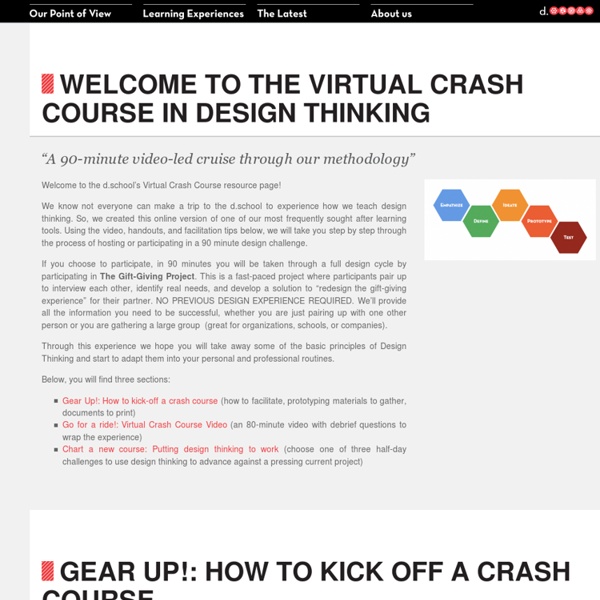What Is Design Thinking?
WHAT IS DESIGN THINKING? Design Thinking is a practical tool for integrating 21st century skills and an innovator’s mindset into the classroom, school and workplace. It demonstrates the direct connection between content students learn in class and what the world beyond their school will ask of them. Students are inspired.
Beginners Guide To Design Thinking
Design Thinking is often used to help understand and solve complex problems. It has been adopted by a range of businesses as it is seen as a way of enabling creative thought in the work place. The idea of using design as a “way of thinking” in science and technology is usually traced to Herbert A. Simon‘s 1969 book The Sciences of the Artificial.
IBM’s Design-Centered Strategy to Set Free the Squares
Photo Phil Gilbert is a tall man with a shaved head and wire-rimmed glasses. He typically wears cowboy boots and bluejeans to work — hardly unusual these days, except he’s an executive at , a company that still has a button-down suit-and-tie reputation.
[Beta] How do you design?
This book is not finished. We’ve been developing it over the past few years. It began as a manilla folder with copies of different process models.
untitled
Now it is possible for teachers to be in two, three or even six places at once. Increase confidence in real-time assessments, maximize quality teacher time with students, and foster effective student collaboration and sharing. Learn More
An Introduction to Design Thinking (Part Two)
In the constructivist-learning model, engagement and experience combine with immersive environments and self-organisation of knowledge to establish a context in which learning occurs naturally. Constructivism has since the time of Dewey become closely affiliated with Project Based Learning and yet despite years of efforts to refine the process the result does not always match the promise (Scheer, Noweski and Meinel. 2012). Scheer et al. argue that ‘Design Thinking’ is capable of providing the structure required for successful constructivist learning and the development of skills required for 21st century citizenship.
Ayelet Lazarovitch
Video Veronika Scott – The Empowerment Plan It’s lovely to see how a complex problem can be solved while offering so much added value. This is the story of how product design and system design intertwined to offer a holistic solution to homeless people. Like this:
When students become entrepreneurs, real learning happens
By Jason Braddock April 16th, 2015 Some students get engaged with cross-curricular, large-scale project-based learning Here in eastern Ohio, some of our students are embracing their entrepreneurial spirit right at school, engaging in a style of learning that helps make lessons come alive.
Ten Things That Happen When Kids Engage in Design Thinking – John Spencer
Creativity and innovation have become buzzwords in education (though not as quite as trendy as hipster beards or skinny jeans). It’s easy to look at the maker movement and write it off as yet another trend in education. But what if it’s not just a trend? What if it’s an idea whose time has come?
5 steps to a problem-solving classroom culture
Math problems can be engaging and thought-provoking with the right instructional strategies Problem solving is one of today’s top skills—students who apply problem-solving strategies in the classroom are building important talents for college and the workforce. The math classroom is one of the best places to help students build these skills.
Project-based learning moves into classrooms
Project-based learning is gaining support in education circles Students at The Ellis School use the Hummingbird Robotics Kit to explore STEM. When it comes to classrooms today, students want more than the lectures and quiet classrooms of the past. They want technology to use as learning tools, they want to collaborate, and they want to work on projects that are relevant to their learning and the real world. Through project-based learning (PBL), students achieve a deeper understanding of lessons as they investigate and attempt to solve real-world problems. Part of this approach’s appeal is its ability to impact students of all ages—kindergarten students can collaborate on and explore problems just the same as high school students.
The Double Diamond Model of Product Definition and Design / peterme.com
After I left Adaptive Path and started working in-house, I was disheartened to realize how retrograde most people’s view of design still was, with a focus on styling and execution. I needed a way to communicate the full breadth of activities my team and I did. So, over the past couple of years, I’ve been using a double diamond model for talking about digital product design. It didn’t originate with me — from what I can tell, The UK Design Council created it in 2005. I’ve modified it to more closely track what happens with digital product design. I’ve shown it at a few events, and people seem to appreciate it.
Project-based learning done right
Parkside Elementary school’s “The Compass” program uses project-based learning to get students interested in their education Two years ago, Kyle was a bored kindergartener at Parkside Elementary school in Coral Springs, Fla. “He wasn’t being challenged enough,” said his mother, Chris Beck. Then she found out about The Compass, a program created by Parkside teachers Randy Bitton and Sheree Schulson in 2012, which involves project-based learning. Just recently, Compass students paraded around the school parking lot with homemade floats representing different states.



